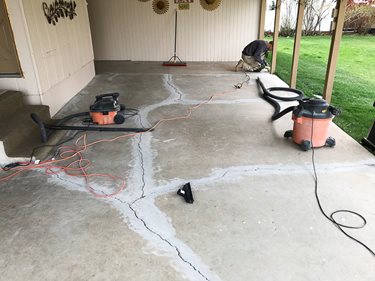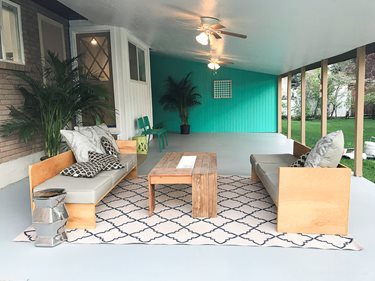- Concrete Patio Info
- Concrete Patio Pictures
- Patio Placement and Layout Tips
- Patio Sizes and Dimensions
- Concrete Patio Finishes
- Patio Designs and Ideas
- Concrete Patio Sealer
- Stamped Concrete and Other Popular Patio Finishes
- Stamped Concrete Patterns
- Resurfacing Concrete Patios
- Stained Concrete Patios
- Painted Concrete Patios
- Exposed Aggregate Patios
- Advantages of Concrete Patios
- Concrete Patio Cost
- Maintenance is a Breeze
- Other Resources
- DIY Concrete Patio
- Review our Comprehensive Section on Stamped Concrete
- Concrete Contractors: Find Products and Supplies in Your Area
- Design Ideas: Concrete Patio Info
A Guide to Painting Concrete Patios
Does your concrete patio or porch need a complete makeover? Applying a coat of paint can be a great solution if you follow these important guidelines.Bethany of Crisp Collective transformed her concrete patio with paint and tape
For many homeowners, concrete patios and porches are extensions of their interior living space, so keeping them looking their best is important. Sometimes that may be as simple as removing unsightly stains and any signs of wear and tear. But with a little time and effort, it’s also possible to completely transform a plain gray concrete patio into a colorful, decorative outdoor floor by applying a coat or two of paint.
Find concrete patio contractors near me.
So what type of paint do you use on a concrete patio, and is painting a concrete patio or porch always a good idea? Before you plunge into a concrete patio painting project, learn more about the pros and cons of painted concrete patios and get tips for choosing and applying exterior concrete paint.
PROS & CONS OF PAINTING CONCRETE PATIOS
PROS
- A major plus of concrete porch and patio paints versus concrete stains is that they come in a much broader selection of colors, allowing you to completely customize your outdoor flooring.
- Today’s exterior concrete paints are designed for high durability and will resist peeling, fading, and abrasion while hiding minor imperfections.
- Can be very economical, especially if you do the work yourself.
- A variety of finishes are possible, ranging from low-luster, to high-gloss, to slightly textured.
CONS
- Paint doesn’t penetrate into the surface like concrete stains do, so weathering and normal wear and tear could cause peeling over time, especially if you don’t prepare the surface properly.
- May require reapplication or occasional touch-ups, especially in high-traffic areas.
- Can result in a slippery surface, unless you use an anti-skid concrete patio paint to improve traction.
WHAT TYPE OF PAINT CAN I USE ON A CONCRETE PATIO?
Not all exterior paints are suitable for concrete patios. You want a product specifically formulated for use on concrete patios and porches, one that contains binders that will allow the coating to expand and contract along with the concrete. The best concrete paints will also resist fading, scuffing, peeling, mildew, and UV exposure.
Most concrete porch and patio paints are heavy-duty acrylic latex formulas that are very effective at concealing minor imperfections and discolorations. These water-based paints are available in a variety of standard and custom colors and in matte, satin, or gloss finishes. Unlike oil-based porch and patio paints, they also offer easy soap-and-water cleanup and are more eco-friendly.
For greater durability, look for a concrete porch and patio paint that is urethane-fortified for superior color retention and adhesion. Also consider using an anti-skid concrete paint that contains a grit additive to improve traction and create a lightly textured finish, especially if your porch or patio is an open area where it can become slippery after exposure to rain or snow.
Learn more about choosing concrete paint.
Justin and Cassity of Remodelaholic ground and filled the cracks in their patio before painting it with a 1-part epoxy floor paint.
HOW DO I PREP A CONCRETE PATIO FOR PAINTING?
Although most concrete patio paints can be applied to previously painted or coated surfaces, be sure to remove any loose or peeling coatings using a wire brush or other abrasion method to sand down to a sound surface. Next, use a concrete degreaser and pressure washer to thoroughly clean the concrete surface from dirt and grime. More stubborn stains such as leaf and grass stains, fertilizer stains, rust, and mold will usually require special cleaners and removal methods. For advice, see Removing Stains from Concrete.
For proper paint adhesion, the concrete surface should also have a slight texture. If the surface is extremely smooth or has a hard-troweled finish, it may need to be acid etched or mechanically abraded first. In addition, some concrete patio and porch paints may require the application of a primer coat to improve bonding. Always read the application instructions on the paint container and follow the manufacturer’s recommendations.
CAN I PAINT A CONCRETE PATIO THAT HAS CRACKS?
Because concrete porch and patio paints are opaque and applied thickly, they do a good job of hiding hairline cracks and other minor flaws in existing concrete. But if you have larger cracks, gouges, or holes in the concrete surface, you will need to patch them first with an exterior concrete crack filler. (Learn more about repairing cracks in concrete patios.) If the cracks are especially large and require extensive repair, you may be better off resurfacing your concrete patio with an overlay rather than painting it.
HOW DO I APPLY CONCRETE PORCH AND PATIO PAINT?
The application tools and procedures for painting a concrete patio are really no different than those for painting a concrete floor (see our guide to painted concrete floors). However, because you will be working outdoors, be sure to take the following precautions:
- Water-based exterior concrete paint requires certain conditions to cure properly. Ideally, choose a day to paint when exterior temperatures are between 50° to 85° F and won’t drop below 32° F for several days after.
- If your concrete patio is exposed to the elements, do not apply paint if rain is expected within 24 hours.
- For the most durable finish, apply two coats of paint at the suggested coverage rate given on the paint container. Most manufacturers recommend a minimum dry time of 4 to 6 hours between coats, but that can vary depending on outdoor air temperatures and humidity levels.
Although most water-based concrete porch and patio paints can be walked on after 24 hours, you should allow the paint to cure for at least 72 hours before returning patio furniture and exposing the surface to heavy traffic.
DO I NEED TO SEAL PAINTED OUTDOOR CONCRETE?
The application or a clear concrete sealer to a painted concrete patio will make your paint job last longer by providing additional protection from stains, moisture, and abrasion. Although a sealer isn’t necessary, it’s a good idea for painted concrete exposed to harsh weather conditions and heavy traffic. For the best results, apply a water-based acrylic sealer designed for exterior use and make sure the product is compatible with the paint you are using.
IS PAINTING A CONCRETE PATIO A DIY PROJECT?
In most cases, painting a concrete patio or porch yourself is an easy way to completely transform an outdoor space, and the materials and application tools can be found at many home-improvement stores. But you may want to consider hiring a professional concrete contractor if your patio requires extensive surface preparation or you have a large project to tackle. Although using a professional will add significantly to the overall cost, it’s often worth the extra expense to make sure the job is done right. Keep in mind that if your DIY attempt fails, it can be very time consuming and labor intensive to strip paint from a concrete surface.
PAINTED CONCRETE PATIO DESIGN IDEAS
- Color match your patio floor to your home’s exterior or the surrounding landscape.
- Use painter’s tape to create bold stripes, checkerboard designs, diamond patterns, or borders. Or get creative and apply your own multicolored designs and patterns.
- Apply faux brick, cobblestone, or faux tile patterns to your painted patio using adhesive-backed stencils.
- If you are having trouble choosing a concrete patio paint color, go with a neutral shade of gray, brown, or tan. Unless your concrete patio or porch is shaded, avoid black or other dark paint colors that can absorb the heat of the sun and make the surface uncomfortably hot.
RELATED:
Concrete Patio Pictures
7 Concrete Patio Finishes
Stenciled Concrete Patio







